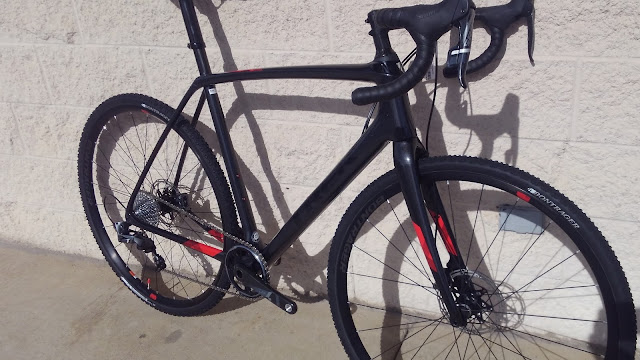- Follow I-80 east past Evanston
- Before reaching Bridger, take Exit 30 (Bigelow Road at the TA gas station)
- Turn right onto 202 (202 turns into a dirt road)
- Follow 202 past some windmills on your left and a small energy plant
- Turn left onto 207 (shortly after energy plant)
- Follow 207 south for several miles until you intersect 204 (2014 creates a 'T' in the road)
- Turn left onto 204 and follow several miles until you hit pavement
- Turn right onto 271 (immediately after dirt road converts to pavement)
- Continue on 271 past Meek's Cabin Reservoir
- 271 changes to FR065 past Meek's Cabin Reserviour
- Cross the bridge over Blacks Fork River
- Turn right onto FR064 (shortly after crossing bridge)
- Follow FR064 to the trailhead
We planned on a three-day, two-night stay. I was able to comfortably pack all my food and gear into six dry bags holding a total of 70L. I had two 5L Salsa Anything Cage Bags and Anything Cages on my fork legs, one 20L bag on my front rack, one 20L bag on the rear rack (top), and two 10L bags on the sides of the rear rack. I carried a Camelbak Skyline on my back with my water and bike tools. I've included some images of how it all packed down:
The Trek 1120 was amazing! What a fun ride! I'm 5'9" tall with goofy long legs and arms. I usually ride an 18.5" Fuel EX. This model isn't offered in an 18.5", so instead of going smaller I decided to go a bit bigger. Bigger makes sense: more comfort with a higher front end and a bit more stability with the longer wheelbase. I test rode the 17.5" before making my decision, and I felt like my weight was too far extended over the handlebar. The 1120 comes stock with a front and rear rack installed. The front rack securely cradles my 20L drybag. With only two nylon straps, I was able to firmly secure the bag to where there was no shifting or readjusting. The rear rack secured my other 20L bag just as easily. The rear rack further includes two harnesses that will secure 10L bags to either side of the rear wheel. the drybags slide in nicely, and with only a little effort, everything can be adjusted so there is no unwanted movement. Everything stayed snug and secure for the duration of the trip with exception of one bolt that worked itself loose on the rear rack (nothing a little Loctite won't fix).
I only made a few minor modifications to the stock bike: I ended up swapping out the Chupacabra tires for some Maxxis Chronicles. They offer a little more volume for the size (29X2.8), and they look really good. I also installed a wider Bontrager Line Pro handlebar and a shorter Bontrager Line Pro stem. I made this switch because I like the feel of a mountain bike cockpit for comfort and handling. I was really happy with the results on the ride.
The ride in was slow, but really pretty and actually quite fun. I'm used to hiking these same trails, so I've gotten used to the amount of time it takes to span certain distances. The bike definitely makes light work of the straightaways and meadows. There were plenty of challenging areas too. Of course, I like technical riding, so this was right up my alley; however, if you're not into the techy rough stuff, you may want to avoid this adventure. Because we're single-track climbing over 10,000 feet, the challenges were plentiful, and the dead fall crossings were frequent. There were only a few hike-a-bike sections though, and everything was ride-able on the descent which made getting out a breeze.
We ran out of light and set up camp at 3.5 miles in. There are plenty of nice areas to find a soft spot to pitch a tent and to make a small fire pit. We set up about 100 yards off the trail nearest the river for easy access to water.
The next morning we left our camp set up and took the bikes (now much lighter) up toward our goal of Bob's Lake (Tokewanna Peak was under a bit too much snow). We had fun exploring the several cabin remains from 1920 loggers that line the trail. We were able to ride the bikes another four miles and finally ditched them to hike the rest. There was too much snow for the bikes, and the trail was getting tough to follow. The hike was easy enough so long as we kept the river within ear-shot. The toughest section of trail with the most elevation gain was the last 1.5 miles to the lake. Bob's lake sits in a bowl just northwest of Tokewanna Peak near 11,500'. Other than the wind, the temperature was really nice. We were able to comfortably cook up a lunch of Raman Noodles and hot cocoa. Scrumdidliumpcious.
This area promises to be a perfect location for September camping. Had we planned this just one month earlier, we could've summited Tokewanna (13,165'). If you like to get away from groups of people, and if you don't shy away from technical climbs, this trail is definitley worthy of your time. Have a happy adventure!





































